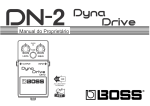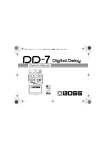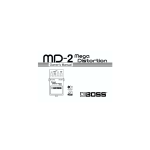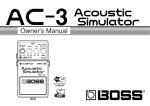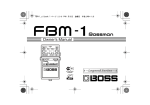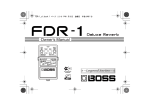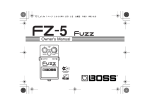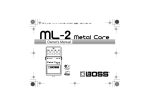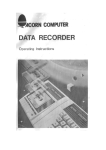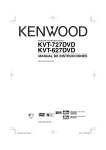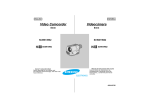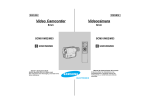Download Boss CEB-3 Bass Chorus Owner`s manual
Transcript
Owner’s Manual AC DC AC & BATTERY POWERED FET Thank you, and congratulations on your choice of BOSS CEB-3 Bass Chorus. Before using this unit, carefully read the sections entitled: “USING THE UNIT SAFELY” and “IMPORTANT NOTES” (separate sheet). These sections provide important information concerning the proper operation of the unit. Additionally, in order to feel assured that you have gained a good grasp of every feature provided by your new unit, this manual should be read in its entirety. The manual should be saved and kept on hand as a convenient reference. A battery is supplied with the unit. The life of this battery may be limited, however, since its primary purpose was to enable testing. Copyright © 2001 BOSS CORPORATION All rights reserved. No part of this publication may be reproduced in any form without the written permission of BOSS CORPORATION. 2 Features ● The BOSS CEB-3 is a chorus unit that is specifically designed for electric bass guitar. ● The CEB-3 allows you to select the frequency band to which the chorus effect will apply. That is, you can have the effect applied to the overall sound, or only a specific frequency range if you wish. ● Using the two channel outputs, deeper chorus effects can be created. 3 Panel Description 1. AC Adaptor Jack fig.01 1 2 Accepts connection of an AC Adaptor (optionally available BOSS PSA-Series). By using an AC Adaptor, you can play without being concerned about how much battery power you have left. 3 6 4 5 4 * Use only the specified AC adaptor (PSASeries), and make sure the line voltage at the installation matches the input voltage specified on the AC adaptor's body. Other AC adaptors may use a different polarity, or be designed for a different voltage, so their use could result in damage, malfunction, or electric shock. * As soon as you connect the AC adaptor, the unit is turned on. * If there is battery in the unit while an AC adaptor is being used, normal operation will continue should the line voltage be interrupted (power blackout or power cord disconnection). Panel Description 2. CHECK Indicator 3. OUTPUT A (MONO)/ OUTPUT B Jack This indicator shows whether an effect is ON/OFF, and also doubles as the Battery Check indicator. The indicator lights when an effect is ON. The output jacks are used to connect the unit to an amplifier or another effects unit. * If this indicator goes dim or no longer lights while an effect is ON, the battery is near exhaustion and should be replaced immediately. For instructions on changing the batteries, refer to “Changing the Battery” (p. 11). * The CHECK indicator shows whether the effect is being applied or not, and is used to indicate other effects. It does not indicate whether the power to the device is on or not. * For monaural output, use Output jack A. Both the dry and processed signals are output. * For stereo use: Output A: Only the processed signal (pitch modulated sound) is output. The dry (unprocessed) signal is not output. Output B: Only the dry signal is output. The CEB-3 adopts the “space synthesis system” for stereo output. That is, the depth of the effect varies depending on the distance between speakers. Note that lowering a filter control knob or effect level too much will shift the sound image to the Output B position, and therefore diminish the effect. Experiment with different as you play the instrument 5 Panel Description 4. Pedal Switch 6. INPUT Jack Used for switching effects on/off. This jack accepts input signals (coming from a bass guitar, some other musical instrument, or another effects unit). 5. Thumbscrew When this screw is loosened, the pedal will open, allowing you to change the battery. * For instructions on changing the batteries, refer to “Changing the Battery” (p. 11). 6 * When running the unit on battery power, the INPUT jack double as power switches. Power to the unit is turned on when you plug into the INPUT jack; the power is turned off when the cable is unplugged. Be sure to disconnect any cord plugged into the INPUT jack when not using this effects device. Panel Description 8. LOW FILTER Knob This knob controls the lower frequencies of the effect sound. As you rotate the knob clockwise, the chorus effect will be applied to a wider range of lower frequencies. Conversely, rotating the knob counterclockwise will cut lower frequencies, causing only the upper frequencies to take on the chorus effect. 7 8 9 10 9. RATE (moduration rate) Knob fig.02 7. E. LEVEL (effect level) Knob This knob adjusts the level of the effect sound (in relation to the input signal). Rotating the knob clockwise increases the level of the effect sound. This knob adjusts the speed of the chorus effect. Rotating the knob clockwise increases the speed. 10. DEPTH (moduration depth) Knob This knob adjusts the depth of the chorus effect. Rotating the knob clockwise deepens the effect. 7 Connections fig.03 AC Adaptor BOSS PSA-series (option) OUT 9V DC/200mA Bass Guitar Bass Amplifier For monoural use, make the connection to the OUTPUT A (MONO) jack. 8 Connections * Inserting a plug into the INPUT Jack will automatically switch the unit on. * Noise may be produced if wireless communications devices, such as cell phones, are operated in the vicinity of this unit. Such noise could occur when receiving or initiating a call, or while conversing. Should you experience such problems, you should relocate such wireless devices so they are at a greater distance from this unit, or switch them off. * To prevent malfunction and/or damage to speakers or other devices, always turn down the volume, and turn off the power on all devices before making any connections. * If there are batteries in the unit while an AC adaptor is being used, normal operation will continue should the line voltage be interrupted (power blackout or power cord disconnection). * Once the connections have been completed (p. 8), turn on power to your various devices in the order specified. By turning on devices in the wrong order, you risk causing malfunction and/or damage to speakers and other devices. When powering up: Turn on the power to your guitar amp last. When powering down: Turn off the power to your guitar amp first. * Always make sure to have the volume level turned down before switching on power. Even with the volume all the way down, you may still hear some sound when the power is switched on, but this is normal, and does not indicate a malfunction. * When operating on battery power only, the unit’s indicator will become dim when battery power gets too low. Replace the battery as soon as possible. 9 Operating the Unit 1. When you have made the necessary connections, set the knobs as shown in the illustration. fig.05 2. Depress the pedal switch to turn the effect on. (Make sure that the CHECK Indicator lights.) 3. Adjust the speed of the chorus effect using the RATE Knob. 6 5 3 4 4. Adjust the depth of the chorus effect using the DEPTH Knob. 5. Using the LOW FILTER Knob, adjust the frequency band to which the chorus effect should be applied. 6. Adjust the volume of the processed sound using the E. LEVEL Knob. 10 Changing the Battery When the indicator goes dim or no longer lights while an effect is on, it means that the battery is nearly dead and must be replaced. Replace the battery following the steps below. fig.09 Thumbscrew Pedal Spring Base Battery Snap Cord Coil Spring Guide Bush Hole Battery Snap Battery Housing 9V Battery 1. Loosen the thumbscrew at the front of the pedal, then lift the pedal upwards to open the unit. * The thumbscrew can be left in the pedal while changing the battery. 2. Remove the old battery from the battery housing, and remove the snap cord connected to it. 3. Connect the snap cord to the new battery, and place the battery inside the battery housing. * Be sure to carefully observe the battery's polarity (+ versus –). 4. Slip the coil spring onto the spring base on the back of the pedal, then close the pedal. * Carefully avoid getting the snap cord caught in the coil spring. 5. Finally, insert the thumbscrew into the guide bush hole and fasten it securely. 11 Setting Samples Clear Chorus Modern Chorus fig.10 fig.12 Slapping Play Vibrato fig.11 fig.13 12 Specifications CEB-3: Bass Chorus Nominal Input Level...................-20 dBu Input Impedance..........................1 MΩ Nominal Output Level................-20 dBu Output Impedance ......................1 kΩ Recommended Load Impedance ....10 kΩ or greater Residual Noise Level...................-86 dBu (IHF-A, Typ.) Controls.........................................Pedal Switch E. LEVEL (effect level) Knob LOW FILTER Knob RATE (modulation rate) Knob DEPTH (modulation depth) Knob Indicator........................................CHECK Indicator (serves also as battery check indicator) Connectors....................................INPUT Jack OUTPUT A (MONO) Jack OUTPUT B Jack AC Adaptor Jack (DC 9 V) Power Supply...............................DC 9 V: Dry Battery 9 V type (6F22/9 V) AC Adaptor 13 Specifications Current Draw ...............................22 mA (DC 9 V) * Expected battery life under continuous use: Carbon: 12 hours These figures will vary depending on the actual conditions of use. Dimensions ...................................73 (W) x 129 (D) x 59 (H) mm 2-7/8 (W) x 5-1/8 (D) x 2-3/8 (H) inches Weight ...........................................450 g / 1 lb (including battery) Accessories....................................Owner’s Manual Leaflet (“USING THE UNIT SAFELY,” “IMPORTANT NOTES,” and “Information”) Dry Battery 9 V type (6F22/9 V) Options..........................................AC Adaptor PSA-Series * 0 dBu = 0.775 Vrms * In the interest of product improvement, the specifications and/or appearance of this unit are subject to change without prior notice. 14 For EU Countries This product complies with the requirements of European Directive 89/336/EEC. For the USA FEDERAL COMMUNICATIONS COMMISSION RADIO FREQUENCY INTERFERENCE STATEMENT This equipment has been tested and found to comply with the limits for a Class B digital device, pursuant to Part 15 of the FCC Rules. These limits are designed to provide reasonable protection against harmful interference in a residential installation. This equipment generates, uses, and can radiate radio frequency energy and, if not installed and used in accordance with the instructions, may cause harmful interference to radio communications. However, there is no guarantee that interference will not occur in a particular installation. If this equipment does cause harmful interference to radio or television reception, which can be determined by turning the equipment off and on, the user is encouraged to try to correct the interference by one or more of the following measures: – Reorient or relocate the receiving antenna. – Increase the separation between the equipment and receiver. – Connect the equipment into an outlet on a circuit different from that to which the receiver is connected. – Consult the dealer or an experienced radio/TV technician for help. This device complies with Part 15 of the FCC Rules. Operation is subject to the following two conditions: (1) This device may not cause harmful interference, and (2) This device must accept any interference received, including interference that may cause undesired operation. Unauthorized changes or modification to this system can void the users authority to operate this equipment. This equipment requires shielded interface cables in order to meet FCC class B Limit. For Canada NOTICE This Class B digital apparatus meets all requirements of the Canadian Interference-Causing Equipment Regulations. AVIS Cet appareil numérique de la classe B respecte toutes les exigences du Règlement sur le matériel brouilleur du Canada. G261720601
















